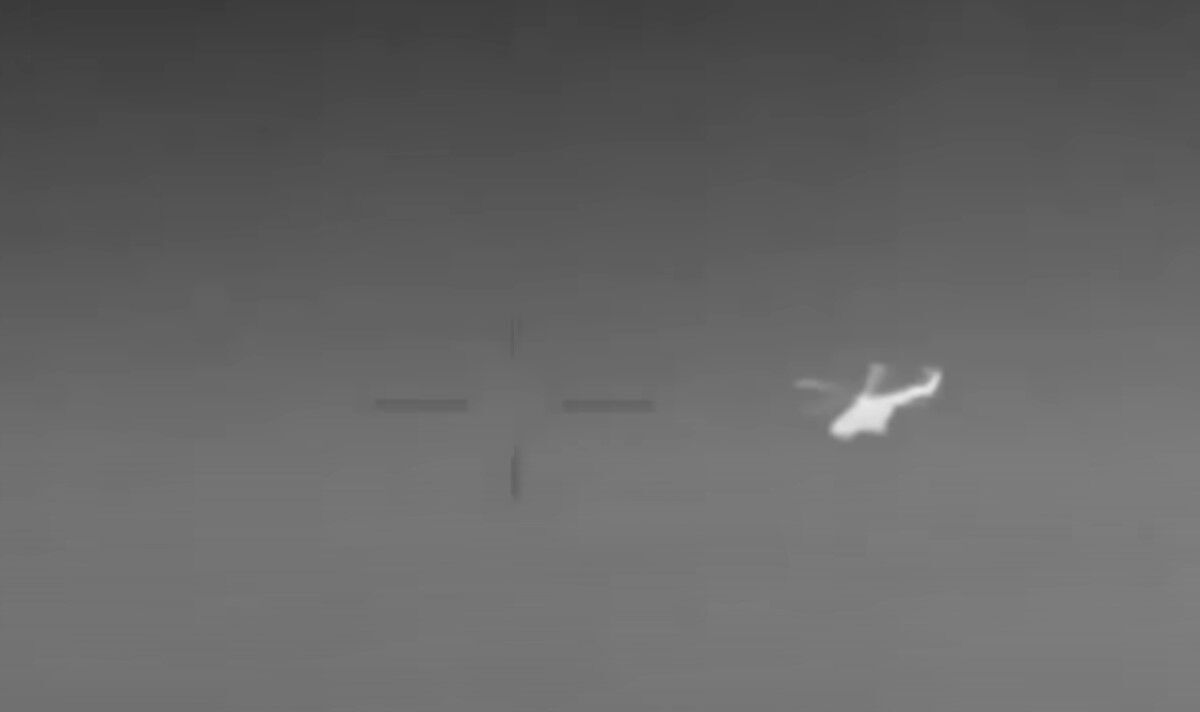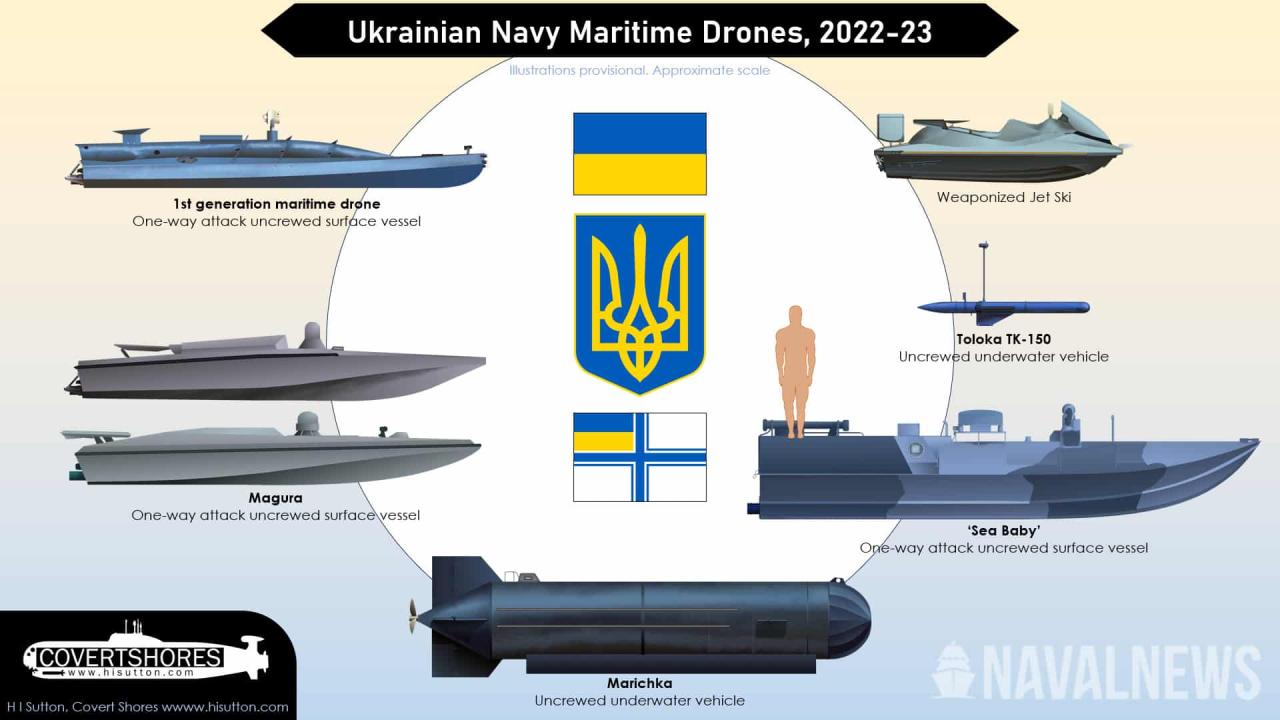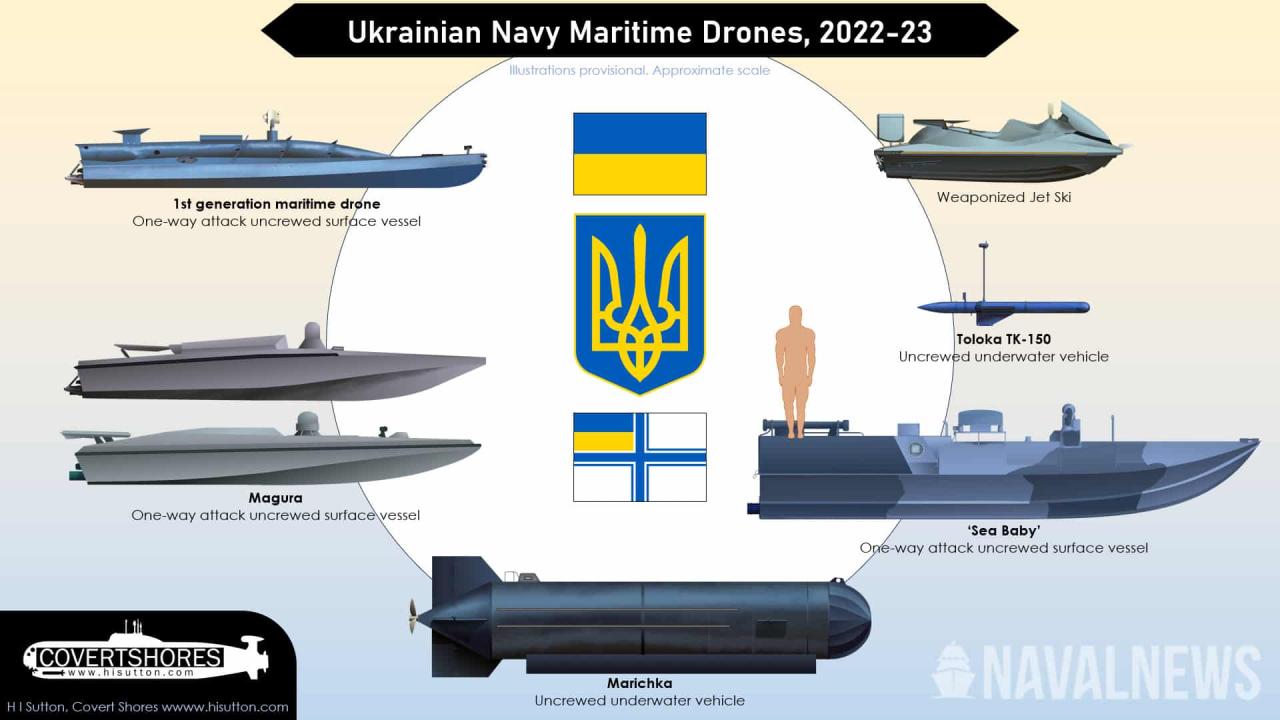Ukrainian sea drones are rapidly changing naval warfare. These unmanned vessels, ranging from small, expendable craft to more sophisticated autonomous systems, are proving surprisingly effective in the ongoing conflict. This exploration delves into their technology, operational use, impact, and future potential, offering a comprehensive overview of this burgeoning field.
We’ll examine the different types of Ukrainian sea drones, their capabilities and limitations, comparing them to similar technologies used by other nations. We’ll also look at how they are being used strategically and tactically, the challenges involved in their deployment, and the economic and geopolitical implications of this technology.
Ukrainian Sea Drone Technology
Ukraine’s burgeoning sea drone program represents a significant shift in naval warfare capabilities, leveraging relatively low-cost, easily deployable assets to achieve strategic and tactical impact. While lacking the scale and sophistication of major naval powers, Ukrainian sea drone technology demonstrates impressive innovation and adaptability, particularly in the context of asymmetric warfare.
Ukrainian sea drones are proving to be surprisingly effective, showcasing the adaptability of unmanned technology in modern warfare. Thinking about the scale of impact, it’s interesting to compare this to other unexpected events involving unmanned vehicles, like the recent fullerton plane crash , which highlighted the potential dangers of even smaller aircraft. The lessons learned from both incidents could inform future drone development and safety regulations for Ukrainian sea drones and beyond.
Current State of Ukrainian Sea Drone Technology
Ukrainian sea drone technology is characterized by its rapid development and pragmatic approach. Capabilities include various payload options, ranging from explosive charges to reconnaissance equipment. Limitations stem primarily from limited production capacity, potential vulnerabilities to electronic warfare, and reliance on readily available components. While lacking the advanced AI and autonomous navigation systems of some Western counterparts, Ukrainian drones demonstrate effective functionality in their designed operational environments.
Comparison with Other Nations’ Sea Drone Technology
Compared to nations like the US, Israel, or China, Ukrainian sea drone technology is less advanced in terms of autonomy, sensor sophistication, and overall range. However, it exhibits a high degree of cost-effectiveness and adaptability, making it suitable for the specific needs of Ukraine’s defense strategy. The focus is on achieving practical results with readily available technology rather than competing in a technological arms race.
Types of Ukrainian Sea Drones and Their Applications
Ukraine employs a variety of sea drones, each tailored to specific missions. These include smaller, expendable drones for suicide attacks against naval vessels, larger drones for reconnaissance and surveillance, and potentially drones equipped for mine-laying or electronic warfare. The exact specifications of many models remain classified.
Materials and Components Used in Construction
The construction of Ukrainian sea drones likely involves readily available commercial components, focusing on affordability and ease of maintenance. Materials probably include fiberglass, aluminum, and commercially available electronics and propulsion systems. This reliance on readily available materials allows for faster production and easier repair in the field.
Specifications of Ukrainian Sea Drone Models

| Model | Size (approx.) | Payload (approx.) | Range (approx.) | Speed (approx.) |
|---|---|---|---|---|
| Model A (Hypothetical) | Small, boat-like | 50 kg explosives | 100 km | 20 knots |
| Model B (Hypothetical) | Medium, unmanned surface vessel | Reconnaissance equipment | 300 km | 15 knots |
| Model C (Hypothetical) | Large, modular design | Variable, up to 200 kg | 500 km | 10 knots |
Operational Use of Ukrainian Sea Drones
Documented operational deployments of Ukrainian sea drones are largely limited due to operational security. However, reports indicate their successful use in attacks against Russian naval vessels and infrastructure in the Black Sea. The effectiveness of these operations highlights the strategic and tactical advantages of using sea drones in maritime warfare.
Ukrainian sea drones are making waves in naval warfare, showcasing impressive autonomous capabilities. It’s a far cry from the dazzling spectacle of a drone show, like the amazing shanghai dragon drone show , but both highlight the rapid advancements in drone technology. However, the Ukrainian drones’ tactical applications are a serious contrast to the entertainment value of the Shanghai display.
Examples of Operational Deployments
While specific details are scarce due to security concerns, reports suggest the successful use of Ukrainian sea drones in targeting Russian landing craft, patrol boats, and other naval assets. These attacks have demonstrated the potential for low-cost, high-impact asymmetric warfare at sea.
Ukrainian sea drones are proving surprisingly effective, showcasing the power of smaller, autonomous systems. Think about how that tech could evolve – imagine the scale of a display like the one at the shanghai drone show 2038 , but instead of a light show, it’s a coordinated swarm of naval drones. The future of naval warfare might be a lot smaller and more agile than we think, thanks to innovations like those seen in the Ukrainian conflict.
Strategic and Tactical Advantages
The use of sea drones offers several key advantages: cost-effectiveness, reduced risk to human life, potential for swarm tactics, and the ability to target high-value assets with relative ease. Their low profile and relatively simple construction make them difficult to detect and counter effectively.
Control and Navigation Methods
Ukrainian sea drones are likely controlled through a combination of pre-programmed routes and remote operator control, potentially via satellite or other long-range communication links. The exact methods remain largely undisclosed for security reasons.
Challenges and Limitations in Deployment
Challenges include vulnerability to electronic warfare, limitations in range and payload capacity, and the logistical complexities of deployment and maintenance in a contested maritime environment. Environmental factors, such as weather conditions, also pose significant operational limitations.
Logistical Considerations
- Secure launch and recovery sites
- Reliable communication infrastructure
- Effective training and maintenance programs
- Countermeasures against enemy electronic warfare
- Supply chain for spare parts and munitions
Impact and Implications of Ukrainian Sea Drone Technology
Ukrainian sea drone technology is reshaping naval warfare strategies, demonstrating the potential for smaller nations to leverage asymmetric capabilities to challenge larger, more technologically advanced navies. The implications extend beyond the immediate conflict, influencing future naval arms races and the development of countermeasures.
Impact on Naval Warfare Strategies
The success of Ukrainian sea drones has highlighted the vulnerability of larger, more expensive naval assets to relatively inexpensive, easily deployable attacks. This is forcing a reassessment of naval defense strategies and the development of new countermeasures.
Potential for Escalation or De-escalation
The use of sea drones could potentially both escalate and de-escalate conflicts. While capable of inflicting significant damage, their limited destructive capacity compared to larger weapons systems might reduce the risk of large-scale escalation. However, their use could also provoke retaliatory actions, leading to an escalation of hostilities.
Economic Implications
The relatively low cost of sea drone technology makes it accessible to smaller nations and non-state actors, potentially leveling the playing field in naval conflicts. This presents a significant economic challenge to nations relying on expensive, large-scale naval assets.
Influence on Future Naval Arms Races
The effectiveness of Ukrainian sea drone technology is likely to stimulate an arms race, both in the development of more advanced sea drones and in the creation of countermeasures. This could lead to a significant increase in naval spending globally.
Hypothetical Naval Engagement, Ukrainian sea drone

Imagine a scenario where a swarm of Ukrainian sea drones, equipped with both explosive and reconnaissance payloads, targets a Russian naval task force. Some drones could be sacrificed to overwhelm defensive systems, while others gather intelligence before launching attacks on high-value targets. The outcome would depend on the effectiveness of Russian countermeasures and the scale of the drone deployment.
Future Developments and Predictions
Future advancements in Ukrainian sea drone technology are likely to focus on increased autonomy, improved sensor capabilities, enhanced range and payload capacity, and greater resilience against electronic warfare. Predicting the exact trajectory is difficult, but certain trends are evident.
Potential Future Advancements
We can expect to see advancements in AI-powered navigation and targeting systems, improved propulsion systems for longer range and speed, and the integration of more sophisticated sensors, such as advanced radar and sonar. The use of swarm tactics and improved communication systems will also likely be prioritized.
Role of Sea Drones in Future Naval Conflicts
Sea drones are poised to play an increasingly important role in future naval conflicts, acting as a force multiplier for smaller navies and providing a cost-effective means of targeting high-value assets. Their use will likely become more sophisticated and integrated with other naval assets.
Impact of Technological Developments
Technological developments will lead to more autonomous, resilient, and lethal sea drones. This will necessitate the development of increasingly sophisticated countermeasures and defensive strategies by opposing forces.
Comparison with Other Countries’ Development Trajectories

While lagging behind major naval powers, Ukraine’s sea drone development trajectory is likely to mirror global trends. We can expect to see similar advancements in autonomy, sensor technology, and swarm tactics across multiple nations.
Timeline of Potential Milestones
- 2024-2026: Increased autonomy and improved sensor integration.
- 2027-2029: Development of larger, more capable drones with increased range and payload.
- 2030-2035: Widespread adoption of swarm tactics and AI-powered decision-making.
Detailed Description of a Specific Ukrainian Sea Drone
Let’s consider a hypothetical advanced Ukrainian sea drone, designated “Neptune-X”. This drone would be a medium-sized unmanned surface vessel, approximately 8 meters in length and weighing around 3 tons. Its propulsion system would consist of a combination of electric motors and a diesel generator for extended range. The Neptune-X would have a payload capacity of up to 150 kg, allowing for a combination of explosives, reconnaissance equipment, or electronic warfare systems.
Neptune-X Specifications and Capabilities
The Neptune-X would have an operational range of approximately 400 km and a maximum speed of 25 knots. Its control system would utilize a combination of satellite communication and pre-programmed waypoints, allowing for both remote operation and autonomous navigation. The drone would be equipped with advanced sensors, including radar, electro-optical cameras, and sonar, for situational awareness and target acquisition.
Countermeasures would include electronic jamming capabilities and decoy systems.
Design Features and Engineering Considerations
The design would prioritize modularity, allowing for easy customization of payloads and sensors based on mission requirements. Emphasis would be placed on robustness and ease of maintenance, given the likely operational environment. Materials would be selected for durability, cost-effectiveness, and resistance to saltwater corrosion.
Operational Capabilities in Various Scenarios
The Neptune-X could be used for a variety of missions, including reconnaissance, surveillance, anti-ship attacks, mine-laying, and electronic warfare. Its modular design allows for rapid adaptation to changing operational needs. In a hypothetical scenario, a swarm of Neptune-X drones could be used to overwhelm enemy defenses, gather intelligence, and launch coordinated attacks on high-value targets.
Last Point
Ukrainian sea drones represent a significant shift in naval power dynamics. Their cost-effectiveness, adaptability, and potential for disruptive action make them a force to be reckoned with. As technology advances, we can expect to see even more sophisticated and capable drones emerge, potentially reshaping future naval conflicts and prompting a global arms race in this exciting new domain. The implications are far-reaching, affecting not only military strategies but also economic and geopolitical landscapes.
FAQ Explained
How are Ukrainian sea drones powered?
Power sources vary depending on the drone model, but common options include electric motors powered by batteries, or internal combustion engines.
What kind of sensors do they use?
They often incorporate a variety of sensors, including cameras, radar, sonar, and GPS for navigation and target acquisition.
What is their typical range and endurance?
Range and endurance vary greatly depending on the size and design of the drone, but generally, larger drones offer longer ranges and endurance compared to smaller ones.
How are they controlled?
Control methods range from pre-programmed missions to real-time remote control via satellite or other communication links.
